Turtles¶
Turtle objects know how to draw. Here we explore creating and manipulating them to draw on the screen.
We also look at the two ways the python3 interpreter can execute your python code:
- The interactive interpreter
- Calling the python interpreter on a file that contains code.
Tip
Don’t just read! Type everything and experiment.
Interactive interpreter¶
We launch the python interpreter through cmd.exe:
- Press the two keys ‘Windows + R’ together
- Enter cmd.exe in the search prompt and enter.
A window will appear with a prompt:
C:\Users\greg-lo>
Type python3 to enter the interactive shell:
C:\Users\greg-lo>python
Python 3.4.2 (v3.4.2:8711a0951384, Sep 21 2014, 21:16:45) [MSC v.1600 32 b
it (Intel)] on win32
Type "help", "copyright", "credits" or "license" for more information.
>>> print('Hi')
Now type:
>>> from turtle import Turtle
>>> tess = Turtle()
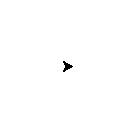
>>> tess.forward(100)
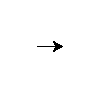
>>> tess.left(30)
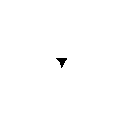
Lets call some more methods on the tess our turtle object:
>>> tess.shape('turtle')
>>> tess.color('green')
Lets create ‘bob’ a new turtle object:
>>> bob = Turtle()
>>> bob.shape('circle')
>>> bob.color('red')
>>> bob.backward(100)
Exercise¶
Experiment drawing shapes in different colours.
Documentation¶
Visit the turtle online documentation and explore what Turtle objects can do.
https://docs.python.org/3/library/turtle.html
Questions:
- What different colors does a turtle’s color method recognise?
- What shapes does a trutle’s shape method recognise?
Find some new turtle object methods and experiment.
Tip
As you experiment you will want to do know how to do new things. Get into the habit of exploring the documenation to see what you can do.
Turtles¶
Lets revise what we have learnt in the light of object oriented terminology.
An object can be created. It has a type, and this type determines its methods (behaviours).
Creation¶
>>> from turtle import Turtle
>>> tess = Turtle()
Breakdown:
- We import an object called Turtle from somewhere called turtle.
- Turtle is called, creates a new object of type turtle, and returns it.
- This returned object is assigned to the name tess.
Tip
We call an object by adding parenthesis at the end of its name. Here the parenthesis are empty but then often aren’t.
Lets confirm the type of tess:
>>> type(tess)
turtle.Turtle
Tip
The function type returns the type of a passed object.
Turtle is a special kind of object in that it produces new objects. We call it a constructor object.
Methods¶
Methods are functions attached to objects. We will explore functions later.
>>> tess.forward(100)
Braces () have a special meaning. They indicate calling. You can think of this as effecting an action.
The effect of calling the method forward on an object of type Turtle is to draw a line.
What other methods (behaviours) do turtle objects have?
Code in files¶
Most code is written and executed from a file.
Using SublimeText create a file named my_turtle_file.py with this code:
from turtle import Turtle, exitonclick
tess = Turtle()
tess.shape("turtle")
tess.forward(100)
exitonclick() # Why this? Experiment by commenting it out.
Tip
All word document file names end with .doc, all files names with python code must end with .py
In cmd.exe call the python command with the filename my_turtle_file.py as parameter:
C:\Users\greg-lo> python3 my_turtle_file.py
Tip
Make sure the file you created exists in the location where you execute this command. The location is given by the prompt.
Questions/Practicals¶
- What are the differences between using python3 interactively and using files? When would you use one or the other?
- Challenge yourself to find as many different ways of drawing with a turtle object.
- Take your time to draw something useful and/or crazy.
Shape Exercises¶
Lets program some shapes. We do this by breaking down into step by step instructions principles of geometry.
Put all code inside a file named shapes.py to be executed using:
python shapes.py
Shapes:
- Draw a square as in the following picture.
Tip
Squares have right angles which are 90 degrees.
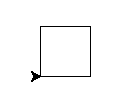
- Draw a rectangle.
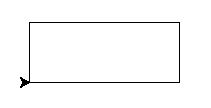
- Draw an equilateral triangle.
Tip
An equilateral triangle has 3 sides of equal length and each corner has an angle of 60 degrees.
- Draw many squares. Each square should be tilted left of the previous.
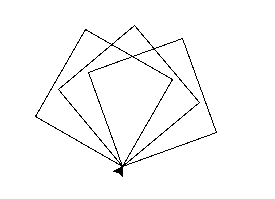
Experiment with the angles between the individual squares. The picture shows three 20 degree turns. You could try 30 and 40...
- Draw a simple house.
Tip
Reuse the code you have already written.